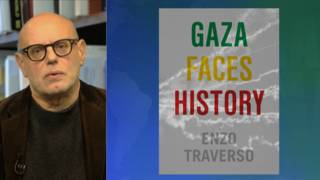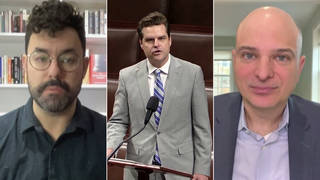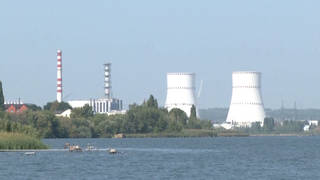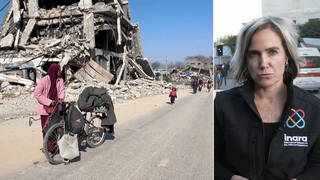
Related
Guests
- Olexi Pasyukdeputy director of the Ukrainian NGO Ecoaction.
- Edwin Lymanauthor and director of nuclear power safety at the Union of Concerned Scientists.
The International Atomic Energy Agency is calling for a safety and security protection zone to be immediately set up around the facility in order to avoid a nuclear disaster at Europe’s largest nuclear power plant. This week it released a long-awaited report urging Russia and Ukraine to create a demilitarized zone around the Zaporizhzhia nuclear power plant, after visiting it last week. “Their warnings are pretty clear: Unless the fighting stops, unless the shelling around and on the plant site stops, … then the plant is really skating on thin ice,” says Edwin Lyman, director of nuclear power safety at the Union of Concerned Scientists. We also go to Kyiv to speak with Olexi Pasyuk, deputy director of Ukrainian environmental group Ecoaction, who says the IAEA report will have limited impact on the fighting but helps raise awareness of the risks. “This is what Ukraine wanted to hear … that the only way to have it safe is to demilitarize the area,” says Pasyuk.
Transcript
AMY GOODMAN: We begin today’s show in Ukraine, where residents near the Russian-held Zaporizhzhia nuclear power plant are being urged to evacuate as fighting continues in the area. The International Atomic Energy Agency is calling for a safety and security protection zone to be immediately set up around the facility in order to avoid a nuclear disaster at Europe’s largest nuclear power plant. The IAEA issued a report Tuesday on the dire conditions at the plant, after investigators visited the site last week. Russia and Ukraine have accused each other of attacking the plant, which has been controlled by Russia since March. The IAEA Director General Rafael Grossi spoke Tuesday.
RAFAEL GROSSI: The physical attack, wittingly or unwittingly, the hits that this facility has received and that I could personally see and assess, together with my experts, is simply unacceptable. We are playing with fire, and something very, very catastrophic could take place. … A specific recommendation in my report that the operator should be allowed to return to its clear and routine line of responsibilities and authorities and that an appropriate work environment must be reestablished, including with proper family support for the staff.
AMY GOODMAN: Ukraine is now considering shutting down the Zaporizhzhia nuclear power station over safety concerns.
For more, we’re joined by two guests. Olexi Pasyuk is with us, deputy director of the Ukrainian NGO Ecoaction, where his focus is on energy and nuclear energy. And Edwin Lyman is joining us, director of nuclear power safety at the Union of Concerned Scientists, co-author of the book Fukushima: The story of a Nuclear Disaster. He recently wrote an article headlined “Can the Zaporizhzhia Nuclear Plant Avoid a Major Disaster?”
We welcome you both to Democracy Now!, from D.C. and Kyiv. Let’s go to Washington, D.C., first. Edwin Lyman, your assessment of the IAEA report? How dire is the situation? Can a nuclear disaster be averted?
EDWIN LYMAN: Well, Amy, the IAEA doesn’t usually use such strong language, so I think it’s important to take notice when they do. And their warnings are pretty clear: Unless the fighting stops, unless the shelling around and on the plant site stops and it allows workers to be able to restore the backup power systems that are now all disabled, then the plant is really skating on thin ice and is very unstable. So there is a great concern here.
NERMEEN SHAIKH: And, Olexi, could you respond to the IAEA report? Your response to their assessment of the situation at the nuclear power plant?
OLEXI PASYUK: Yeah. Hello. Well, first of all, I think we need to understand the nature of the International Atomic Energy Agency. I think there are a lot of expectation from organization, and which has a pretty limited impact. I mean, they were designed, basically, to promote nuclear, while also trying to prevent spread of the radioactive materials. So, I personally didn’t expect much from their visit to the power plant, because the [inaudible] just the fact that the Russian army is enough to bring this concern, because they intervened, basically, in safety processes which are on the plant. So, this is what Ukraine wanted to hear, to get the confirmation news that Russia basically intervened in the safety, and the idea that the only way to have it safe is to demilitarize the area.
NERMEEN SHAIKH: Can you give us some background here? I mean, Russia occupied this plant in March, very soon after their invasion of Ukraine. Why do you think they occupied the plant? I mean, this plant provides something like 20% of all of Ukraine’s electric supply.
OLEXI PASYUK: Well, I think we must stress, really, this fact that the sole fact that they attacked a power plant was, in a way, already breaking Geneva Convention protocol, which says this kind of site shouldn’t be attacked. It comes to the nuclear or to big dams. And it’s actually in violation of a couple of decisions made by International Atomic Energy Agency member states.
Why they did it? Well, first of all, as you try to cover the area and there is a nuclear power plant, basically, it’s on your way you go to there. But, indeed, it’s the biggest power plant in the region — I mean, in Europe. And this is the nature of nuclear power, unfortunately, that you have these major power plants where the generation is very much concentrated. So, once you’re in control of the plant, you are in control of the big chunk of electricity production. But also, I think Russia at this moment uses the power plant as a kind of a safe base, because Ukrainians is obviously very limited in the amount of military attack they can put on the military which is now on the site. And Russia is using the site of nuclear power plant to basically attack Ukraine over the river with artillery.
AMY GOODMAN: Olexi Pasyuk, can you explain the military situation around Zaporizhzhia? I mean, extremely significant. You have both Russia and Ukraine accusing the other of the shelling. What do you understand is happening, and how the plant is being used? And how many of the plants themselves — what? — there are six there; this is the largest station in Europe — have been shut down already?
OLEXI PASYUK: Look, let me start from the last one. I think this is one of the discussions which is happening as to why, out of six units, there were recently like two units working. It’s even on the — right after attack, when Russia occupied the station, when they were shooting on the site, there were two units which were operating. They were shut down, but then they were restarted again. This is because the power plant is important as electricity source for the region, both for occupied territories, where Russia wants also to have electricity supply, and the Ukrainian-controlled territories.
So, in terms of military, that area is under Russian control, in general, but there is something which we cannot really have details about what is happening all around, because there was shooting from different sides, which is difficult to estimate. We have some evidence when there were Ukrainians were attacking — there is this footage — on some of the Russian, like, soldiers, basically, on the camp just outside the power plant. But as to the attacks on site, it’s difficult indeed to say who does it, because there is also this question that there are like four electricity lines going out of the power plant, and there could be different interests to put them down.
NERMEEN SHAIKH: And, Edwin Lyman, I mean, one of the things that the IAEA report concluded is that there’s no indication, at least at the moment, of elevated radiation levels at the plant, though the Ukrainian nuclear state company has said that radiation-monitoring sensors have been damaged, and so it’s not really possible to measure radiation levels so accurately and elevation in radiation levels. Could you comment on that and what you think is going on?
EDWIN LYMAN: Yes. Well, by all accounts, there haven’t been any — enough damage to any of the safety systems to compromise the nuclear reactor safety or the safety of spent fuel. There was damage to a building that houses low-level radioactive waste, and that could have led to some release of contamination, but probably nothing that you would detect far from the site. But it’s also important to know that it is very possible to measure very, very low levels of radioactivity far away from the actual release. So, if there were a larger release of radioactivity, it could be detected in Western Europe and other stations around the world. So there’s no way that it could be concealed for very long if there were a severe event at the plant.
However, the situation is unstable. Right now there’s apparently no offsite power going to the plant. And my understanding is only one reactor is operating, at very low power, and it’s only operating to power itself and the other reactors which are shut down. And so, this one reactor is holding itself up by its bootstraps. That’s an unusual and unstable configuration for a nuclear power plant, and that’s, again, a great concern. Unless the offsite power is restored rapidly, then this plant should be shut down.
AMY GOODMAN: Can you respond, Edwin Lyman, to the European Union set to donate five-and-a-half million potassium iodide tablets to Ukraine, this to deal with the possibility of radiation around Zaporizhzhia? Explain what that means.
EDWIN LYMAN: Yes. Well, in a nuclear reactor accident, one of the major releases of radioactivity is a radioactive isotope of iodine. And because the thyroid takes up iodine preferentially, that radioactive iodine can concentrate in the thyroid and deliver radiation to a small area and significantly increase the risk of cancer. And after the Chernobyl accident in 1986, one of the most obvious consequences was an epidemic of thyroid cancer among children, ordinarily a very unusual disease. So, there were many thousands, possibly tens of thousands, of thyroid cancers associated with that accident. If you take stable iodine within six hours of exposure, it will prevent the uptake of the radioactive iodine. So that’s one measure for addressing that one consequence of a nuclear accident. But a nuclear reactor is a soup of hundreds of different isotopes, and they all interact with the body in different ways. And radioactive — or, stable iodine can only address one of those pathways.
NERMEEN SHAIKH: And, Edwin Lyman, you know, one of the issues that the IAEA report raised is the situation for workers at the plant, who have been working now, of course, for several months under conditions of extreme stress, on top of which some of the operating staff at the facility don’t have unrestricted access to some areas. That is, no staff have access to some areas in the facility. So, could you talk about that, the concerns about workers being exhausted and working under stressful conditions, and also what it means that — what the risks are of workers not being granted access, unrestricted access, to certain areas of the plant?
EDWIN LYMAN: Yes, you can’t really understate the importance of the personnel in the operation of a nuclear power plant, both under normal conditions and under emergency conditions. My understanding is that the staffing at the plant is perhaps less than half it was before the invasion. That itself is a concern, putting undue burden on those that are left. But you compound that with the pressure that the Russian military is putting on the staff, that may influence their ability to carry out their activities in an unrestricted fashion. And it’s also important to have clear lines of command, as IAEA Director General Grossi pointed out. If there is an accident, you have to know who’s in charge. And there may only be a matter of a few hours to respond before preventing a meltdown. So, it’s very important that the staff be well rested, not be under stress, know who’s in command, and be able to do what they need to do and go where they need to go. And if they can’t, if there’s any indication of those restrictions, then it raises questions about the ability of the personnel to respond effectively to an accident.
Another issue is the fire brigade. A fire in a nuclear power plant is a very severe event and could lead to widespread damage to safety systems and lead to multiple meltdowns. However, the fire brigade at the Zaporizhzhia had to be relocated because shelling damaged the fire station on the site. That means they’re going to have a longer time to respond if something does happen in the plant. So, all these are of great concern.
AMY GOODMAN: Edwin, I wanted to ask you about the nuclear power plants, not only in Ukraine but all over, related to climate change, this catastrophe that’s being experienced around the world. When we were at the U.N. climate summit in Katowice a few years ago, afterwards I flew to Ukraine. And in so many towns and cities, there are monuments to those who died at Chernobyl. That was a different situation, but explain the crisis of climate change and nuclear power, when water levels go down that cool the fuel rods.
EDWIN LYMAN: Yes. Well, nuclear power plants are often touted as a solution to climate change, because when they operate, they don’t release greenhouse gases. But you have to consider that in the context of their risks compared to renewable energy sources that don’t have the potential for a catastrophic accident.
And what you’re referring to is the impact of climate change on nuclear power and the fact that nuclear power plants, at least current-generation plants, require a consistent, steady supply of cool water to remove heat from the cores when they’re operating. So, if climate change stresses nuclear power plants by droughts, by reducing water levels in lakes and rivers, and by increasing temperature, that puts constraints on the operation of nuclear plants, because they can’t — they can’t operate if the cooling water they have access to is too warm, so that when you see heat waves — and we’ve seen this in France, but also occasionally in the United States, when water levels — when water temperatures get too high, the plants have to derate or even shut down. So, that’s certainly something you have to keep in mind when you think about increasing the use of nuclear power as a climate mitigation option.
NERMEEN SHAIKH: And, Edwin, you’ve raised concerns also about what the impact of this might be on agricultural lands around the plant and well beyond it. You know, Ukraine is considered one of the breadbaskets of the world. What do you think — what are your concerns about that? And did you have similar concerns also — you’ve co-authored a book on Fukushima — what happened following that disaster, as well as Chernobyl?
EDWIN LYMAN: When you consider all the impacts of a large release of radioactivity from a nuclear plant accident, you have to consider both the direct impacts of exposure on the public, but also you have to look at the contamination of water supplies and the contamination of agricultural lands. And certainly, in Fukushima prefecture, there was widespread radiological contamination that not only led to the need to sample and occasionally interdict food supplies, both agricultural products and, of course, fish, because the fishing industry in that prefecture was critical, but even when the detected radiation levels were lower, there was still the psychological stigma associated with foodstuffs that come from the vicinity of the accident.
But in the case of Ukraine, Zaporizhzhia is located near these very fertile agricultural lands. And even if a radiological release didn’t travel that far, for instance, across the international borders, it could still have a big impact on agriculture there and potentially taint the exports that are so important to the rest of the world.
AMY GOODMAN: Well, Edwin Lyman, we want to thank you for being with us, director of nuclear power safety at the Union of Concerned Scientists, co-author of Fukushima: The Story of a Nuclear Disaster. And we’ll link to your piece, “Can the Zaporizhzhia Nuclear Plant Avoid a Major Disaster?” And we want to thank Olexi Pasyuk in Kyiv, Ukraine, with the Ukrainian NGO Ecoaction.
Next up, Somalia is facing a looming famine. We’ll go to Mogadishu to speak with the U.N. humanitarian coordinator for Somalia, and we’ll go to Ethiopia, where drought is devastating East Africa. Stay with us.












Media Options